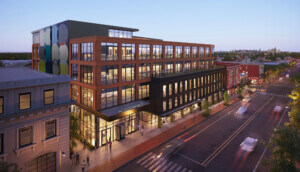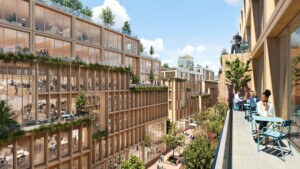Following heated protests and a short-lived hunger strike, the San Jose City Council voted last week to approve the rezoning of the area around the city’s beloved Berryessa Flea Market to make way for a sprawling mixed-use development. The new complex will sit directly adjacent to the Bay Area Rapid Transit (BART)’s Berryessa/North San José station.
A 60-plus-year-old Silicon Valley institution and hub of commerce and civic life for the region’s Latino community, the storied swap meet won’t disappear entirely to make way for the 270-acre Berryessa BART Urban Village, the first regional transit urban village to be developed in California’s third most populous city. The landmark flea market, a self-described “small city with a life of its own,” originally spanning 120 acres with a quarter-mile-long strand of produce stalls and parking lots as far as the eye could see, will, however, dramatically shrink in size. This has led to ongoing concerns about the impact the redevelopment will have on the livelihoods of the market’s longtime vendors. The Berryessa Flea Market, when incorporated into the new development as a new “urban market,” will be five acres; a mere sliver of its current 15-acre size.
As reported by the Mercury News, San Jose City Council’s unanimous June 29 vote to greenlight the rezoning followed a marathon 15-hour meeting held the previous week. At that time, city officials failed to reach a consensus regarding the future of the market, better known as simply La Pulga by its loyal and positively massive base of shoppers. The vote also followed a hunger strike organized by the Berryessa Flea Market Vendors Association in protest of the planned development. The two-day strike concluded on June 24 after a vote on the rezoning measure was delayed for a week following the contentious negotiation meeting.
Per the Mercury News, the vote enables the site’s owner, the Bumb family, and the project developer to boost the total number of planned new residential units at the site from 2,468 to 3,450 while expanding the amount of commercial office and retail space from 315,022 square feet to as high as 3.4 million square feet. Additionally, the development plan provides vendors with a $5 million package, doubled in recent weeks from an initial $2.5 million, meant to provide them with financial security once La Pulga is shuttered in its current form. The fund will be overseen by a Flea Market Advisory Group comprised of city staff, vendors, and flea market representatives.
Along with the fund, an additional provision stipulates that the market will remain open for at least another three years ahead of construction and that no current vendors can be evicted ahead of its closure.
“We definitely didn’t get everything that we wanted, but looking at it from where we started in December, this is a whole hell of a lot more than they were offering then,” Roberto Gonzalez, president of the Berryessa Flea Market Vendors Association, told the Mercury News. “Through our organizing effort, our collaboration with the community and them standing in solidarity with us, we basically started a whole movement to save La Pulga and that’s what I’m most proud of.”
While the fully desired outcome—a $15 million fund to aid displaced vendors and a 10-acre market within the new development—was not met, the grassroots movement to save some of La Pulga and support its vendors through the transition certainly had an impact. Initially, the Bumb family made no agreement to provide financial aid to vendors and did not entertain the idea of incorporating a downsized version of the market into the development. Also, only a one-year notice would have been given to vendors leading up to the closure of the market.
As part of the development scheme, city officials, at the request of San Jose Mayor Sam Liccardo, also agreed to attempt to iron out a deal with the Valley Transportation Authority (VTA) to identify areas around the BART station, such as parking lots, that could potentially be used to expand the downsized market on busy weekends. There are also plans to identify various public funding sources that could further assist vendors impacted by the redevelopment, according to the Mercury News.
“The market in its current form will close,” elaborated councilman David Cohen in a statement shared by NBC Bay Area. “Our interest was keeping the market there, or at least some version of it, that would allow us to pay homage to that cultural and economic center in our region.”
Plans for high-density, transit-oriented development next to BART’s intermodal transit center, the first to be completed in San Jose, have been in the works since 2007—long before the BART station was even completed. The station opened for VTA bus service in 2019 while BART’s rapid transit line debuted at the station in June 2020. It currently serves as the terminus of the BART-S Line, which will eventually extend into downtown San Jose with subway service.
George Bumb Sr. founded the landmark flea market along Berryessa Road in March 1960 at the site of an old meat processing plant on the northern outskirts of the city. While vendors at the Berryessa Flea Market initially sold produce and other comestibles along with essential domestic wares, it has evolved over the decades into an enduring regional shopping destination where one can procure truly anything under the sun: electronics, jewelry, clothing, cosmetics, cookware, art, and much more. Mixed among the roughly 750 vendor stalls (430 are currently occupied, per the Mercury News) are a wide range of permanent restaurants and roving food carts. La Pulga is also famed for its festive atmosphere, family-friendly diversions including a vintage carousel, and live entertainment, namely Mexican Mariachi bands.
As noted in a May op-ed published by San Jose Inside, the Berryessa Flea Market attracts more annual visitors (north of 4 million) than all four major Bay Area sports stadiums combined. Per a historical analysis of the site, the flea market is not only the largest open-air market in the United States but is also on of the most highly attended permanent outdoor attraction in the country, second only to the Disney and Universal Studios theme parks in Southern California and Florida. “[…] for Latinos, it is much more than a marketplace—La Pulga serves as a combination of a plaza and market that provides an irreplaceable recreational and civic space for our community,” reads the op-ed. “It is a vibrant Mercado that has given Latinos a cultural and economic foothold in a landscape that has largely ignored our existence.”











